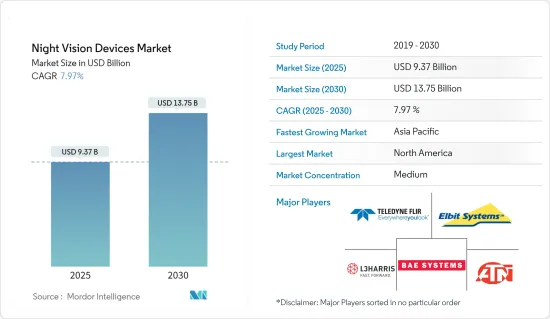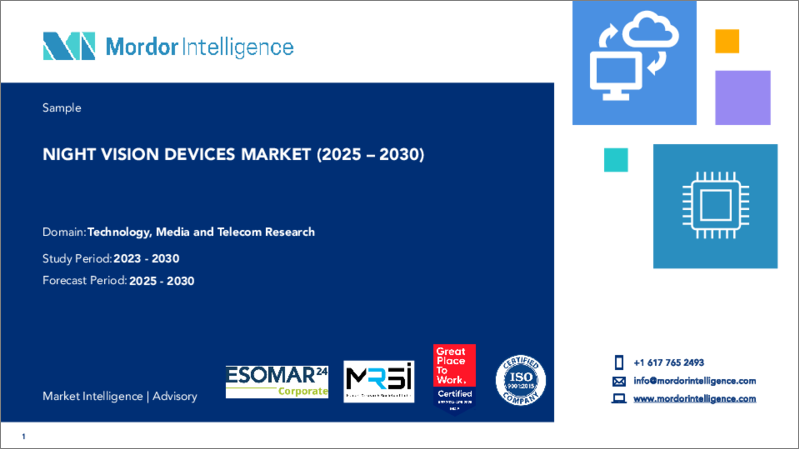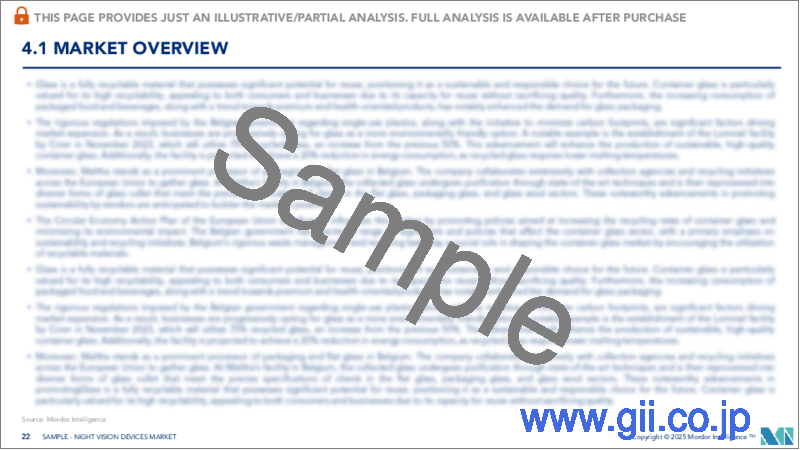|
|
市場調査レポート
商品コード
1689875
暗視装置:市場シェア分析、産業動向・統計、成長予測(2025年~2030年)Night Vision Devices - Market Share Analysis, Industry Trends & Statistics, Growth Forecasts (2025 - 2030) |
||||||
カスタマイズ可能
適宜更新あり
|
|||||||
| 暗視装置:市場シェア分析、産業動向・統計、成長予測(2025年~2030年) |
|
出版日: 2025年03月18日
発行: Mordor Intelligence
ページ情報: 英文 154 Pages
納期: 2~3営業日
|
全表示
- 概要
- 目次
暗視装置市場規模は2025年に93億7,000万米ドルと予測され、2030年には137億5,000万米ドルに達すると予測され、予測期間(2025年~2030年)のCAGRは7.97%です。

暗視機能は、低照度での警備や完全な暗闇での夜間監視に採用されることが多いです。暗視機能付き赤外線カメラは、仕事や趣味で暗闇を監視する必要がある人に最適です。赤外線カメラは、完全な暗闇や低照度の条件下でより良い写真を作成するために、通常の照明スペクトルではなく、赤外線光(イルミネーター)を使用しています。現在、多くのセキュリティ・システムには、昼用と夜用の両方のカメラが搭載されています。
暗視装置は、戦場の暗い状況下で兵士にカラー映像を提供します。これらの機器は、近年、山火事の専門家の間で魅力を獲得しており、機器の需要が増加すると予想されています。需要は、ヘッドマウント暗視装置や低コストなどの技術的およびアプリケーションの実現可能性によって促進されました。これらのガジェットは、夜間に150~200ヤード以上の明瞭な視界を提供します。
市場の成長を促す主な要因は、軍事費の増大です。テロリズムや不法移民などの問題により世界の安全保障上の脅威が深まるにつれ、世界各国は最新技術の装置や武器、弾薬を自国の軍隊に装備させるために軍事費を増大させています。例えば、SIPRIによると、世界の軍事費は2017年の1兆8,070億米ドルに対し、2022年には2兆2,400億米ドルに達します。軍事近代化への支出が拡大すると予想される中、こうした動向は市場成長にとって有利なエコシステムを生み出すと予想されます。
しかし、暗視装置の高価格と、透明な障害物を通した照準の限界などの技術的限界は、調査した市場の成長にとって引き続き主要な課題となっています。
COVID-19の世界的流行は、調査対象市場の成長に顕著な影響を与えています。例えば、COVID-19の初期には、様々な産業の世界のサプライチェーンが混乱し、製造やその他の産業用途に使用される原材料や部品が不足する結果となりました。さらに、手作業による労働力の使用が制限されたことも、パンデミックの影響をさらに強めました。パンデミックの最中、エンドユーザーのさまざまな業種の組織も、それほど重要でない要件に高額を費やすことを避けた。そのため、市場は減速を目の当たりにしました。
しかし、状況が徐々に改善し、サプライチェーンの圧力が緩和されたことで、さまざまな業種の業界が成長を報告しました。パンデミックのさまざまな業種への影響が軽減され、需要と供給の両面で市場環境が正常化したため、今後もこの傾向が続くと予想されます。その結果、COVID-19後の市場の成長は期待できそうです。
暗視装置市場動向
監視用途が大きなシェアを占める
- 暗視装置は軍隊の重要な小道具であり、ほとんどの近代的軍隊は兵士一人一人に暗視装置を装備しています。夜間視力は、軍隊が地域を防衛したり、戦車や危害を加えようとする人物などの脅威をスキャンしたりする際に役立ちます。この装置を使用している間は、光が風景に反射するため、すべてのものが緑がかって見えます。
- 車載用では、暗視装置は民間市場でますます一般的に使用されるようになっています。悪天候や夜間において、自動車用暗視装置はドライバーの知覚と視認距離を向上させることができます。通常、赤外線や赤外線画像でデータを取得し、アクティブイルミネーションと組み合わせてドライバーに見せる。暗視装置はまた、航空機やヘリコプター、低照度での狩猟、夜間射撃競技にも使用されています。
- 最近では、SWIRまたは短波長赤外線暗視装置カメラシステムが車両ナビゲーションに使用されています。トラック、戦車、装甲兵員輸送車などの軍事用地上輸送車両は完全な暗闇の中で活動しなければならないため、短波長赤外線(SWIR)照明とセンサーを備えた拡張ビジョンシステム(EVS)の需要が高まっています。短波長赤外線暗視カメラシステムにより、危険な領域でも目立たないように行動することができます。SWIRカメラは、MWIRやLWIRとは異なり、フロントガラス越しに撮影できるため、運転席から前方の道路を見渡すことができます。また、頑丈なアウトサイドハウジングにもSWIRカメラを取り付けることができます。
- 2024年1月、レーザー光源の商品化企業である京セラエスエルディーレーザー株式会社(KSLD)は、可視スペクトル領域のアプリケーション向けInGaNレーザーダイオードを含む、レーザーライトの新機能を発表しました。同社は、海中、防衛、セキュリティ用途のLiFiイノベーションを開拓しています。
- レーザーライトモジュールベースのヘッドライトは、暗視装置とセンシング用に高輝度の白色と赤外(IR)デュアル照明を提供します。同社のレーザーライトLiFiシステムは、1Gbpsの双方向トランスミッションで白色と赤外光を照射し、将来のワイヤレス接続をサポートします。青色レーザー駆動技術は、システムの能力を水中アプリケーションに拡大します。レーザーライトモジュールは超小型で、レンズの高さが12.7mm以下のスリムな形状となっています。
- NATOによると、2023年、NATO加盟国の国防費は合計で約1兆2,600億米ドルとなり、NATO加盟国が提供された期間中に国防費に費やした総額の中で最高となります。様々な地域での軍事費の増大も調査対象市場の成長をもたらしています。各国政府は軍事力の向上にますます力を注いでおり、暗視装置の採用機会を提供しています。
- このような開発は、予測期間中の軍事・防衛産業における暗視装置市場の成長を促進すると予測されます。
北米が大きな市場シェアを占める
- 同地域では軍事・防衛への支出が増加しているため、企業は研究開発活動を行うことができ、その結果、イノベーションがもたらされ、国民と国境の安全・安心をよりよく管理することができるようになりました。さらに、夜間の空中消火能力を向上させるために、消防活動での暗視装置の使用が増加していることも、この地域での暗視装置の採用を増加させています。
- 技術の進歩により、暗視装置は機械学習や拡張現実(Augmented Reality)と統合され、暗視装置の暗視能力を高めることができるようになりました。さらに、米国陸軍は最近、強化型暗視ゴーグル-双眼鏡(ENVG-B)を使用して部隊の訓練を開始しました。このゴーグルは、戦場からのデータと画像を兵士の目に直接提供します。このシステムには、高解像度ディスプレイ、内蔵ワイヤレス・パーソナル・ネットワーク、迅速目標捕捉システム、陸軍兵士の暗視能力を強化する拡張現実アルゴリズムが含まれています。
- 2023年11月、レオナルドDRS社は米国陸軍向けの次世代サーマルウェポンサイトの生産を受注しました。1億3,400万米ドルを超えるこの受注は、Family of Weapon Sights-Individual(FWS-I)IDIQ契約に基づくものです。FWS-Iはクリップオン式の照準器で、強化暗視ゴーグル双眼鏡(ENVG-B)や統合視覚補強システム(IVAS)など、ヘルメットに装着する視覚システムにワイヤレスで接続します。兵士に迅速な目標捕捉能力を提供します。DRSの非冷却熱画像技術を活用し、兵士は昼夜を問わず、煙や霧の中でも目標を捕捉できます。今回の提携により、DRSはこの重要な技術を米国陸軍に提供し続けることができます。
- 2023年5月、米連邦航空局(FAA)はエリクソン社製S-64Fエアクレーンヘリコプターの暗視ゴーグル(NVG)運用を認定しました。エリクソンの統合NVGプログラムは、お客様に柔軟性の向上と運用能力の拡大を提供します。また、NVGフライトクルーが現行のFAA規制に準拠していることを保証します。この認証取得により、エリクソンは空中消火活動や市民保護活動において、戦術的な計画と敏捷性を高めることができます。さらに、エリクソンはアビエーション・スペシャリティーズ・アンリミテッド(ASU)と協力し、S-64FをNVG運用のために改造しました。
- したがって、地域政府が開発、統合、実験、実験室やプラットフォームでのテスト、使用中のさまざまなシステムとの統合による評価を通じて暗視装置の能力を進化させることを目指しているため、この地域の市場は成長する可能性が高いです。
暗視装置産業の概要
暗視装置市場は、世界企業と中小企業の両方が存在するため、半固体化しています。市場の主な企業には、Teledyne FLIR LLC、L3harris Technologies Inc.、American Technologies Network Corp.、Elbit Systems Deutschland、BAE Systems PLCなどがあります。市場の企業は、製品提供を強化し、持続可能な競争優位性を獲得するために、提携や買収などの戦略を採用しています。
- 2024年1月-Exosensは、25mmイメージインテンシファイアソリューションの導入を発表。同社のHi-CE MCP技術をベースとし、先進的なHi-QE光電面を利用できます。
- 2023年12月-タレスとスペインの警備会社トラブリサは、インテリジェントな国境管理のために、市民警備隊メリリャ司令部への統合監視システムの設置を完了するために合弁会社を設立。この監視システムにより、市民警備隊は高解像度の昼夜カメラを使用できるようになります。暗視カメラと監視・制御ソフトウェア(HORUS)により、センサーとアクチュエーターの集中管理と制御、画像の処理が可能になります。
その他の特典:
- エクセル形式の市場予測(ME)シート
- 3ヶ月のアナリスト・サポート
目次
第1章 イントロダクション
- 調査の前提条件と市場定義
- 調査範囲
第2章 調査手法
第3章 エグゼクティブサマリー
第4章 市場洞察
- 市場概要
- 業界の魅力度-ポーターのファイブフォース分析
- 供給企業の交渉力
- 買い手の交渉力
- 新規参入業者の脅威
- 代替品の脅威
- 競争企業間の敵対関係
- 業界バリューチェーン分析
- マクロ経済動向の市場への影響評価
第5章 市場力学
- 市場促進要因
- 軍事費の増加
- 法執行機関の採用増加
- 市場抑制要因
- メンテナンスに伴う高コスト
第6章 市場セグメンテーション
- タイプ別
- カメラ
- ゴーグル
- 単眼鏡・双眼鏡
- ライフルスコープ
- その他のタイプ
- 技術別
- サーマルイメージング
- イメージ・インテンシファイア
- 赤外線照明
- その他の技術
- 用途別
- 軍事・防衛
- 野生動物の観察と保護
- 監視
- ナビゲーション
- その他の用途
- 地域別
- 北米
- 欧州
- アジア太平洋
- ラテンアメリカ
- 中東・アフリカ
第7章 競合情勢
- 企業プロファイル
- Teledyne FLIR LLC
- L3Harris Technologies Inc.
- American Technologies Network Corp.
- Elibit Systems Ltd
- BAE Systems PLC
- Thales Group SA
- Raytheon Technologies Corporation
- Bushnell Inc.
- Satir
- Apresys International Inc.
- Luna Optics Inc.
- Opgal Optronic Industries Ltd
- EOTECH LLC
- Exosens
- Panasonic Holding Corporation
- Tak technologies private Limited
- TACTICAL NIGHT VISION COMPANY
- sharp Corporation
- nivisys LLC
- Excelitas Technologies Corp.
第8章 投資分析
第9章 市場の将来
The Night Vision Devices Market size is estimated at USD 9.37 billion in 2025, and is expected to reach USD 13.75 billion by 2030, at a CAGR of 7.97% during the forecast period (2025-2030).

Night vision is often employed in night surveillance at low-light security or completely dark conditions. Infrared cameras with night vision capabilities are excellent for anyone who needs to monitor in the dark for work or pleasure. Infrared cameras use infrared light (illuminator) rather than the usual illumination spectrum to create better photos in complete darkness or low light conditions. Many security systems now include both day and night versions of cameras.
The night vision equipment provides soldiers with color visuals in low-light situations on the battlefield. These devices have acquired appeal among wildfire experts in recent years, which is expected to increase demand for the devices. The demand was fueled by technological and application feasibility, such as head-mounted night vision and low cost. These gadgets provide clear visibility of more than 150 to 200 yards at night.
A major factor driving the market's growth is the growing military expenditure. As the global security threat deepens owing to issues such as terrorism, illegal migration, etc., countries across the globe are increasing their military expenditure to equip their protection forces with the latest technology devices, arms, and ammunition. For instance, according to SIPRI, the global military expenditure reached USD 2.240 trillion in 2022, compared to USD 1.807 trillion in 2017. With expenditures on military modernization anticipated to grow, such trends are anticipated to create a favorable ecosystem for the market's growth.
However, the higher cost and technical limitations of night vision devices, such as their limitations in targeting through transparent obstacles, continue to remain among the major challenging factors for the growth of the market studied.
The global outbreak of COVID-19 has had a notable impact on the growth of the market studied. For instance, during the initial days of COVID-19, the global supply chain of various industries was disrupted, resulting in a scarcity of raw materials and components used in manufacturing and other industrial applications. Furthermore, restrictions imposed on the use of manual workforce further intensified the pandemic's influence. During the pandemic, organizations across different end-user verticals also were averted on spending high on less crucial requirements. Hence, the market witnessed a slowdown.
However, with the conditions gradually improving and supply chain pressure easing out, industries across different sectors reported growth, which is anticipated to be the case going forward as the influence of the pandemic on different verticals has been reducing, leading to the normalization in the market conditions both in terms of demand and supply. As a result, the market's growth in the post-COVID-19 period appears promising.
Night Vision Devices Market Trends
Surveillance Applications to Hold Significant Share
- Night vision devices are crucial gadgets of armed forces, and most modern armies equip each of their soldiers with these devices. Night vision aids military forces in defending an area or scanning for threats, such as tanks or persons wishing to harm them. Because the light reflects off the landscape, everything appears to have a greenish hue while utilizing these devices.
- In automotive, night vision has become increasingly commonly used in the civilian market. In bad weather conditions or at night, automotive night vision systems can increase a driver's perception and viewing distance. Typically, they capture data via infrared or thermal imaging, which is occasionally paired with active illumination techniques, and then show it to the driver. Night vision has also been used in aircraft and helicopters, low-light hunting, and night shooting competitions.
- Recently, SWIR or short-wavelength Infrared Night Vision Camera systems have been used for vehicle navigation. Military ground transport vehicles such as trucks, tanks, and armored personnel carriers must operate in complete darkness, increasing the demand for Enhanced Vision Systems (EVS) with short-wave Infrared (SWIR) illumination and sensors. Infinite short wave infrared night vision camera systems to maneuver discreetly through dangerous territory. SWIR cameras, unlike MWIR and LWIR, can image through the windshield, allowing them to be positioned in the driver's compartment for a "driver's eye" view of the road ahead. Ruggedized outside housings can also accommodate SWIR cameras.
- In January 2024, KYOCERA SLD Laser, Inc. (KSLD), a company in the commercialization of laser light sources, introduced its new LaserLight capabilities, including InGaN Laser Diodes for Applications in the Visible Spectral Range. The company is pioneering LiFi innovations for undersea, defense, and security applications.
- The laserlight module-based headlight offers high-brightness white and infrared (IR) dual illumination for night vision and sensing. The company's laserlight LiFi system offers white and IR illumination with a 1 Gbps bi-directional transmission rate to support the future of wireless connectivity. The blue laser-powered technology expands the system's capability into underwater applications. The laserlight Modules are ultra-compact and have a slim profile with less than a 12.7 mm lens height.
- According to NATO, in 2023, the combined defense expenditure for members of NATO was approximately USD 1.26 trillion, the highest NATO members have collectively spent on defense during the provided period. The growing military expenditure in the various regions also results in the growth of the market under study. Governments are increasingly focusing on improving their military capabilities, thereby providing opportunities for the adoption of night vision devices.
- Such developments are anticipated to propel the growth of the night vision devices market in the military and defense industry during the forecast period.
North America to Hold Significant Market Share
- The increased spending on military and defense in the region has allowed companies to conduct R&D activities, resulting in innovations, enabling them to manage better the safety and security of their people and the borders. Further, increased night vision use in firefighting activities to enhance night-time aerial firefighting capabilities increases the adoption of night vision devices in the region.
- Technological advancements have enabled night vision devices to be integrated with machine learning and Augmented reality to enhance the night vision capabilities of the devices. Further, the US Army recently started training its forces using Enhanced Night Vision Goggle-Binocular (ENVG-B). These goggles provide data and imagery from the battlefield directly to the soldier's eye. The system includes a high-resolution display, an embedded wireless personal network, a rapid target acquisition system, and Augmented reality algorithms that enhance the night vision capabilities of army personnel.
- In November 2023, Leonardo DRS, Inc. received an order for the production of its next-generation thermal weapon sights for the US Army. The production order for more than USD 134 million was made under the Family of Weapon Sights - Individual (FWS-I) IDIQ contract. FWS-I, a clip-on weapon sight, connects wirelessly to helmet-mounted vision systems, including the enhanced night vision goggle binoculars (ENVG-B) and the integrated visual augmentation system (IVAS). It offers rapid target acquisition capabilities to the soldier. It leverages DRS' uncooled thermal imaging technology, enabling soldiers to acquire targets day or night and in smoke or fog. The partnership will help the company to continue to deliver this vital technology to the US Army.
- In May 2023, the Federal Aviation Administration (FAA) certified the Erickson Incorporated S-64F Air-Crane helicopter for night vision goggles (NVG) operation. Erickson's integrated NVG program offers customers increased flexibility and expanded operational capabilities. It ensures that the NVG flight crew maintains accordance with current FAA regulations. The certification will allow the company to increase tactical planning and agility in aerial firefighting and civil protection operations. Further, Erickson also collaborated with Aviation Specialties Unlimited (ASU) to modify S-64F to perform NVG operations.
- Therefore, as the regional governments aim to evolve their night vision capabilities through development, integration, experimentation, laboratory and platform tests, and evaluation with integration with various systems in use, the market in the region is likely to grow.
Night Vision Devices Industry Overview
The night vision devices market is semi-consolidated due to the presence of both global players and small and medium-sized enterprises. Some of the major players in the market are Teledyne FLIR LLC, L3harris Technologies Inc., American Technologies Network Corp., Elbit Systems Deutschland, and BAE Systems PLC. Players in the market are adopting strategies such as partnerships and acquisitions to enhance their product offerings and gain sustainable competitive advantage.
- January 2024 - Exosens announced the introduction of the 25 mm Image Intensifier solution. It is based on the company's Hi-CE MCP technology and is available with advanced Hi-QE photocathodes.
- December 2023 - Thales and the Spanish security company Trablisa formed a joint venture to complete the installation of the integrated surveillance system in the Melilla Command of the Civil Guard for intelligent border control. The surveillance system will enable the Civil Guard with high-resolution day and night cameras. The night vision cameras and the monitoring and control software (HORUS) allow the centralized management and control of sensors and actuators as well as the processing of images.
Additional Benefits:
- The market estimate (ME) sheet in Excel format
- 3 months of analyst support
TABLE OF CONTENTS
1 INTRODUCTION
- 1.1 Study Assumptions and Market Definition
- 1.2 Scope of the Study
2 RESEARCH METHODOLOGY
3 EXECUTIVE SUMMARY
4 MARKET INSIGHTS
- 4.1 Market Overview
- 4.2 Industry Attractiveness - Porter's Five Forces Analysis
- 4.2.1 Bargaining Power of Suppliers
- 4.2.2 Bargaining Power of Buyers
- 4.2.3 Threat of New Entrants
- 4.2.4 Threat of Substitutes
- 4.2.5 Intensity of Competitive Rivalry
- 4.3 Industry Value Chain Analysis
- 4.4 Assessment of the Impact of Macroeconomic Trends on the Market
5 MARKET DYNAMICS
- 5.1 Market Drivers
- 5.1.1 Increasing Military Expenditure
- 5.1.2 Increasing Adoption from Law Enforcement
- 5.2 Market Restraints
- 5.2.1 High Costs Associated with Maintenance
6 MARKET SEGMENTATION
- 6.1 By Type
- 6.1.1 Camera
- 6.1.2 Goggles
- 6.1.3 Monoculars and Binoculars
- 6.1.4 Rifle Scope
- 6.1.5 Other Types
- 6.2 By Technology
- 6.2.1 Thermal Imaging
- 6.2.2 Image Intensifier
- 6.2.3 Infrared Illumination
- 6.2.4 Other Technologies
- 6.3 By Application
- 6.3.1 Military and Defense
- 6.3.2 Wildlife Spotting and Conservation
- 6.3.3 Surveillance
- 6.3.4 Navigation
- 6.3.5 Other Applications
- 6.4 By Geography
- 6.4.1 North America
- 6.4.2 Europe
- 6.4.3 Asia Pacific
- 6.4.4 Latin America
- 6.4.5 Middle East and Africa
7 COMPETITIVE LANDSCAPE
- 7.1 Company Profiles
- 7.1.1 Teledyne FLIR LLC
- 7.1.2 L3Harris Technologies Inc.
- 7.1.3 American Technologies Network Corp.
- 7.1.4 Elibit Systems Ltd
- 7.1.5 BAE Systems PLC
- 7.1.6 Thales Group SA
- 7.1.7 Raytheon Technologies Corporation
- 7.1.8 Bushnell Inc.
- 7.1.9 Satir
- 7.1.10 Apresys International Inc.
- 7.1.11 Luna Optics Inc.
- 7.1.12 Opgal Optronic Industries Ltd
- 7.1.13 EOTECH LLC
- 7.1.14 Exosens
- 7.1.15 Panasonic Holding Corporation
- 7.1.16 Tak technologies private Limited
- 7.1.17 TACTICAL NIGHT VISION COMPANY
- 7.1.18 sharp Corporation
- 7.1.19 nivisys LLC
- 7.1.20 Excelitas Technologies Corp.





